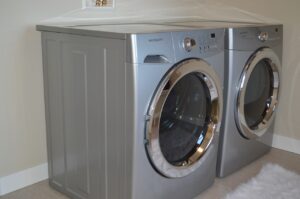Washer troubleshooting is an essential skill for anyone who owns a washing machine. When your washer starts acting up, it can be frustrating and inconvenient. However, before you call a professional or rush out to buy a new machine, it’s important to understand the basics of washer troubleshooting. This blog post aims to provide you with a comprehensive guide to troubleshooting your washer safely and effectively.
The purpose of this blog post is to equip you with the knowledge and skills necessary to identify and fix common washer problems. By understanding the potential risks and hazards involved in washer troubleshooting, as well as the safety precautions you should take, you can ensure that you approach the task with confidence and minimize the chances of accidents or injuries.
Key Takeaways
- Washer troubleshooting requires understanding the importance of safety.
- Basic safety precautions include unplugging the washer and wearing protective gear.
- Common washer problems can pose safety risks, such as electrical shock or burns.
- Safety measures when dealing with electrical components include turning off power and using insulated tools.
- DIY washer troubleshooting should prioritize safety by following safety guidelines and recommendations.
Understanding the Importance of Safety
Safety should always be a top priority when troubleshooting any appliance, including washers. It’s important to remember that washers are electrical appliances that use water, which can be a dangerous combination if not handled properly. Taking safety precautions when troubleshooting your washer can help prevent accidents, injuries, and even potential damage to your home.
One of the main risks involved in washer troubleshooting is the potential for electrical shock. Washers are powered by electricity, and coming into contact with live wires or improperly grounded appliances can result in serious injury or even death. Additionally, water and electricity do not mix well, so it’s crucial to take extra precautions when working with wet environments.
Basic Safety Precautions when Troubleshooting Washers
Before you begin troubleshooting your washer, there are some basic safety precautions you should always follow. First and foremost, make sure to unplug the machine from the power source before attempting any repairs or inspections. This will help prevent accidental electrocution.
It’s also important to wear protective gear when working on your washer. This includes safety goggles to protect your eyes from any flying debris or chemicals, as well as gloves to protect your hands from sharp edges or hot surfaces. Additionally, wearing non-slip shoes can help prevent accidents caused by slipping on wet surfaces.
Common Washer Problems and their Safety Risks
When troubleshooting your washer, it’s important to be aware of the common problems that can arise and the safety risks associated with them. One common issue is a leaking washer, which can pose a slip and fall hazard due to the presence of water on the floor. It’s important to clean up any water spills immediately and ensure that the area is dry before continuing with any repairs.
Another common problem is a washer that won’t drain properly. This can lead to a buildup of water in the machine, which can cause mold and mildew growth if not addressed promptly. When troubleshooting this issue, be sure to wear gloves and protective clothing to avoid coming into contact with any potentially harmful bacteria or chemicals.
Safety Measures when Dealing with Electrical Components
When troubleshooting washers, you may need to work with electrical components such as switches, motors, or control boards. It’s important to take safety measures when dealing with these components to avoid electrical shock or other injuries.
Firstly, always make sure to unplug the washer from the power source before working on any electrical components. This will help prevent accidental electrocution. Additionally, it’s important to use insulated tools when working with live wires or electrical connections. This will help minimize the risk of electrical shock.
Safety Procedures for Handling Water and Detergents

Water and detergents are integral parts of a washer’s operation, but they can also pose safety hazards if not handled properly. When troubleshooting your washer, it’s important to follow safety procedures for handling water and detergents to avoid accidents or injuries.
When working with water, always make sure to turn off the water supply before attempting any repairs or inspections. This will help prevent flooding or accidental spills. Additionally, be cautious when handling wet surfaces to avoid slipping and falling.
When handling detergents, it’s important to read and follow the manufacturer’s instructions carefully. Some detergents can be harmful if ingested or come into contact with the skin or eyes. Always wear gloves and protective clothing when handling detergents to minimize the risk of skin irritation or chemical burns.
Safety Tips for Repairing or Replacing Washer Parts
If you need to repair or replace parts in your washer, it’s important to follow safety tips to ensure that the process is done safely and effectively. When handling new parts, always make sure to read the manufacturer’s instructions carefully and follow them closely. This will help ensure that the parts are installed correctly and reduce the risk of accidents or damage to the machine.
When removing old parts, be cautious of any sharp edges or hot surfaces. Use appropriate tools and techniques to safely remove the parts without causing injury to yourself or damaging the machine. It’s also important to dispose of old parts properly, following any local regulations for hazardous waste disposal.
Safety Guidelines for Testing and Troubleshooting Washers
When testing and troubleshooting your washer, it’s important to follow safety guidelines to avoid accidents or injuries. Before conducting any tests, make sure to unplug the machine from the power source to prevent accidental electrocution.
When conducting tests, always use appropriate tools and equipment. Avoid using makeshift tools or equipment that may not be suitable for the task at hand. Additionally, be cautious of any moving parts or mechanisms in the machine and keep your hands and fingers clear to avoid getting caught or injured.
Safety Recommendations for DIY Washer Troubleshooting
If you’re planning on troubleshooting your washer as a DIY project, there are some safety recommendations you should keep in mind. Firstly, make sure to educate yourself about your specific washer model by reading the user manual and any additional documentation provided by the manufacturer. This will help you understand the machine’s operation and potential safety risks.
It’s also important to know your limits and when to call a professional. If you’re unsure about a particular repair or if it involves complex electrical or mechanical components, it’s best to leave it to the experts. Attempting repairs beyond your skill level can result in further damage to the machine or even personal injury.
Prioritizing Safety in Washer Troubleshooting
In conclusion, prioritizing safety is crucial when troubleshooting your washer. By following basic safety precautions, understanding the potential risks and hazards involved, and taking appropriate safety measures when handling electrical components, water, detergents, and parts, you can ensure that you approach washer troubleshooting with confidence and minimize the chances of accidents or injuries.
Remember to always unplug the machine from the power source before attempting any repairs or inspections, wear protective gear such as goggles and gloves, and follow safety guidelines for testing and troubleshooting washers. If you’re unsure about a particular repair or if it involves complex components, it’s best to call a professional. By prioritizing safety, you can effectively troubleshoot your washer and keep yourself and your home safe.
If you’re looking for more information on washer troubleshooting and maintenance, be sure to check out the related article on 911 Appliance’s blog. This article provides valuable insights and tips on how to keep your washer running smoothly and efficiently. From common issues to troubleshooting techniques, this article is a must-read for anyone who wants to ensure the safety and longevity of their washing machine. Don’t miss out on this informative resource – click here to read it now!
Can Diagnosing and Fixing Washer Issues Help Ensure Washer Safety?
Proper washer troubleshooting and repair can significantly improve washer safety. Identifying and addressing issues such as leaks, electrical malfunctions, or unbalanced loads can prevent serious accidents. Regular maintenance and proper repairs can help ensure that a washer operates safely and efficiently.



